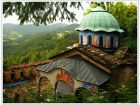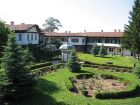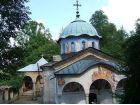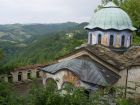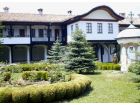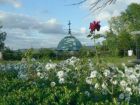Sokolski Monastery
Sokolski Monastery
The monastery was established in 1833 after in the autumn of 1832, Yosif Sokolski arrives to his home region, accompanied by another monk, Agapii.
The two chose the stone terrace in front of the Sokolova Peshtera (Falcon’s Cave) for the place of the new monastery and dug its first church in the limestone rock.
The church was small and wooden, while a primitive wooden house was built next to it.
Everything was finished in January 1833, while the consecration of the church was carried out by the Turnovo metropolitan bishop, Ilarion of Crete on the 15th of August, 1834.
The present-day church was built in 1834, while its inside and outside wallpaintings were finished in 1862 by a priest, Pavel, and his son Nikolay.
The entire monastery, including its fresco, has been recently restored with financial assistance from the EU.
The iconostasis was also completed in 1862 by masters of the Tryavna school of icon-painting, while the church’s main icon was painted by the renowned Gabrovo icon-painter Hristo Tsokev.
It is believed that the icon of the God’s Mother with the Son, put in a small icon-stand in the left part of the church is wonder-working.
The entire monastery complex was finished during Bulgaria’s Renaissance period with the help of donations by Gabrovo citizens and residents of nearby villages.
A valuable architectural monument can be seen in the middle of the monastery’s yard – a big round-shaped fountain, built by the famous master Kolyu Ficheto that still shines with its beauty.
In 1836, a religious school, in which the renowned teacher Neofit Bozveli taught for a while, opened its doors in the monastery.
As its is the case with many other monasteries, the Sokolski cloister was closely connected with the liberation struggle of the Bulgarian people.
In 1865, the flag of the detachment of Captain Dyado Nikola was consecrated here, while on the first of May 1876 the monastery served as a starting point for the Gabrovo participants in the April uprising, led by Tsanko Dyustabanov.
From its establishment until 1959, the monastery was inhabited by monks, while after the illegal destruction of the Gabrovo female monastery its nuns were moved here, transforming it into a female one.
Since 1968, the northern part of the monastery hosts a beautiful chapel with icons of Jesus Christ and the God’s Mother with the Son, painted by the big master Zahari Zograf.





